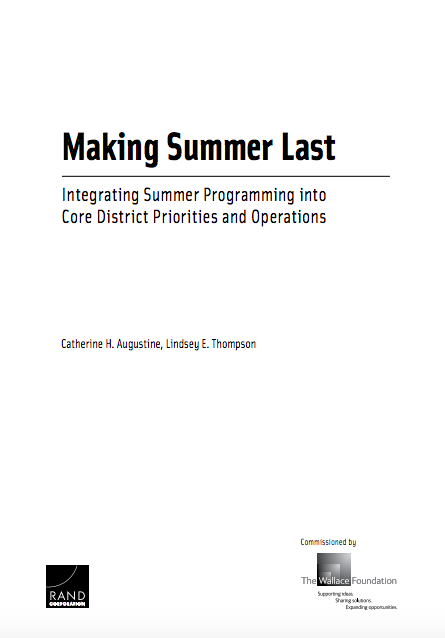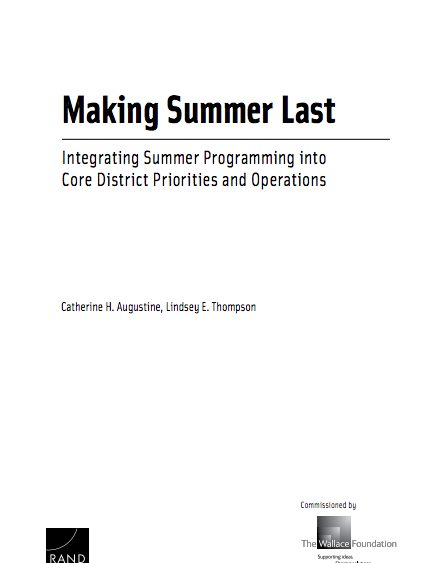 |
Summer learning programs across the country are providing students with valuable opportunities to learn. However, for students from low-income families, quality learning opportunities can be sparse, and students from low-income communities lose more ground academically over their summer than their more affluent peers. Supporting summer learning, and making these programs a priority for school districts, can make a difference for these students year-round. Taking support for these programs to a district level and prioritizing summer learning can help ensure program quality, sustainability, and increase community buy-in.
In an effort to support summer learning programs, The Wallace Foundation launched the National Summer Learning Project (NSLP) across five school districts nationwide in 2011. Evaluating the NSLP programs, RAND has explored outcomes for students participating in summer learning programs. Digging deeper, Making Summer Last: Integrating Summer Programming into Core District Priorities and Operations, a new report from The Wallace Foundation and RAND, explores how three of the school districts participating in NSLP integrated summer learning into their district priorities. The report evaluates interviews with district staff members and summer leadership staff involved in summer programming and highlights their recommendations for making summer a district-wide priority. Here are the report’s three main takeaways, including challenges, to integrate and prioritize summer learning programs into your school district:
Build awareness of summer learning programming and connect programming to district goals
When creating quality summer learning programs for students, it is important to get district-wide support from teachers, district-level staff, and summer instructors.
Exposing all parties to the summer learning program via site visits or videos of the program increased buy-in and helped express the need for and impact of the summer learning programming. Programs also found it important to connect the summer programming to district goals and desired academic outcomes, showing that priorities for the school year and the summer were consistent and that summer learning programming could help accomplish district-wide goals.
Summer leaders, overall, did find it challenging to generate support and buy-in for their programs, especially when summer learning programs were not required by the district. Despite the overall challenge, building awareness of the summer learning programming helped garner support from district staff and in some cases led to increased funding opportunities—especially once superintendents were onboard.
Establish cross-departmental planning
Programs found that a key aspect of creating quality summer learning programming included cross-developmental planning and support. Creating a planning group where representatives from all departments with a hand in summer learning met frequently, starting at the beginning of the school-year, reinforced the importance of summer learning across the district and helped with summer learning implementation. Program leaders found that it was important to make expectations and responsibilities across departments clear, and to include only essential department representatives to minimize confusion and maintain clarity regarding individuals’ roles.
Leverage expertise of district-level staff
Program leaders found that a key part of integrating summer learning programming into district goals was collaborating and communicating with a wide array of district-level departments; such as development, finance, and communications. Creating relationships between these departments and summer learning staff was crucial for progress toward future program sustainability.
For some districts, introducing new tasks related to summer learning stretched staff capacity, and district staff were not always able to meet the deadlines of the summer learning programs. However, incentivizing the additional work and maintaining communication surrounding summer and district staff capacity reduced the effects of these challenges. While some summer staff were able to tap into district staff capacity, the overall recommendation from the report was to utilize district staff knowledge and experience to inform the work of summer staff, not to redistribute tasks to the district-level staff.
Quality summer learning programs have a multitude of short-term benefits for the students that participate, but they also can help support the long-term learning that takes place throughout the school year. Integrating summer learning as a priority within the school district can amplify these benefits. For programs looking to start, expand, or restructure their summer learning efforts, incorporating the recommendations from Making Summer Last can be a good place to start, and can ultimately lead to a higher-quality and more sustainable program.
Read the full report online, and keep an eye out for two more upcoming reports from The Wallace Foundation on summer learning policy and sustainability.

Comments are closed.